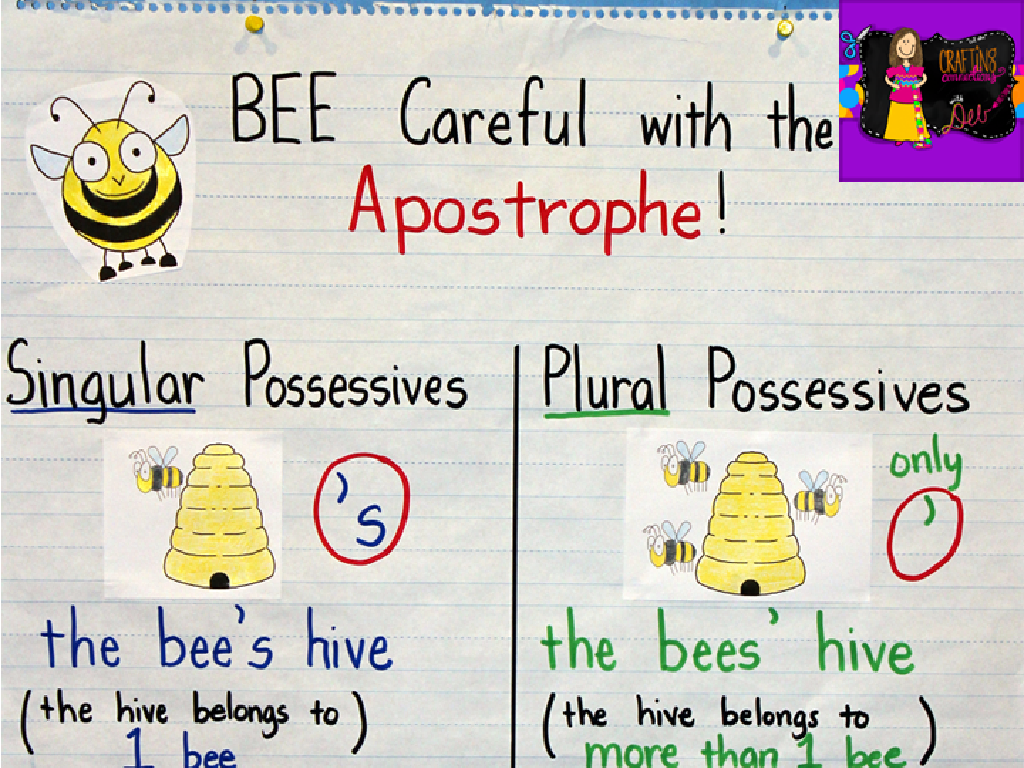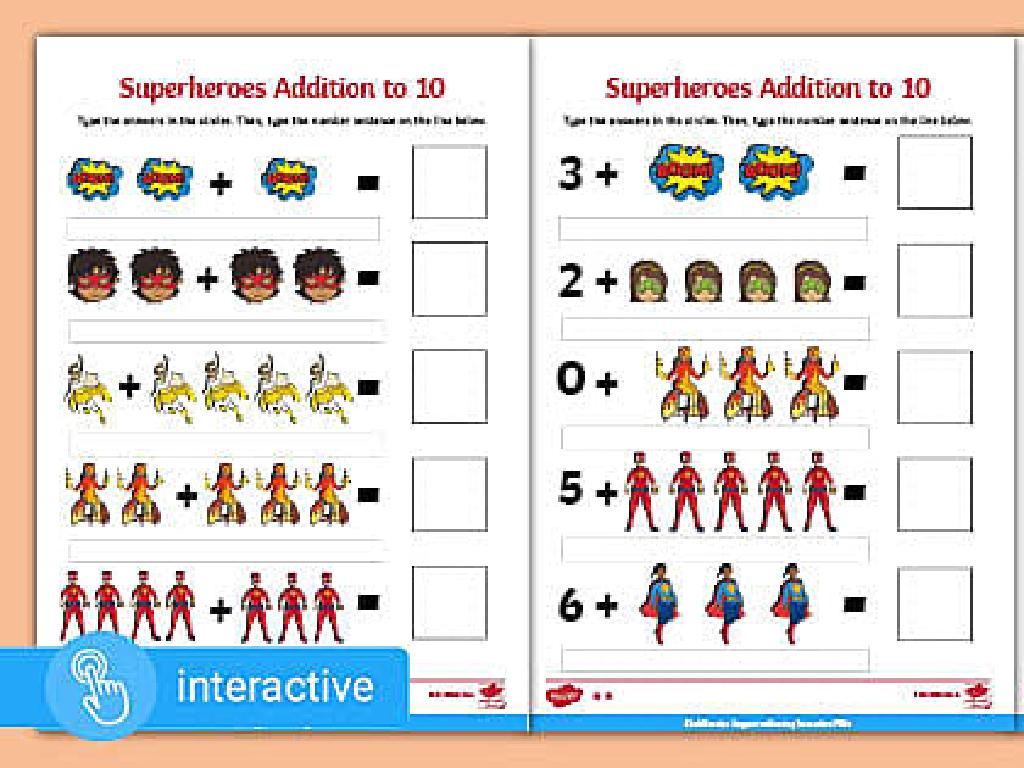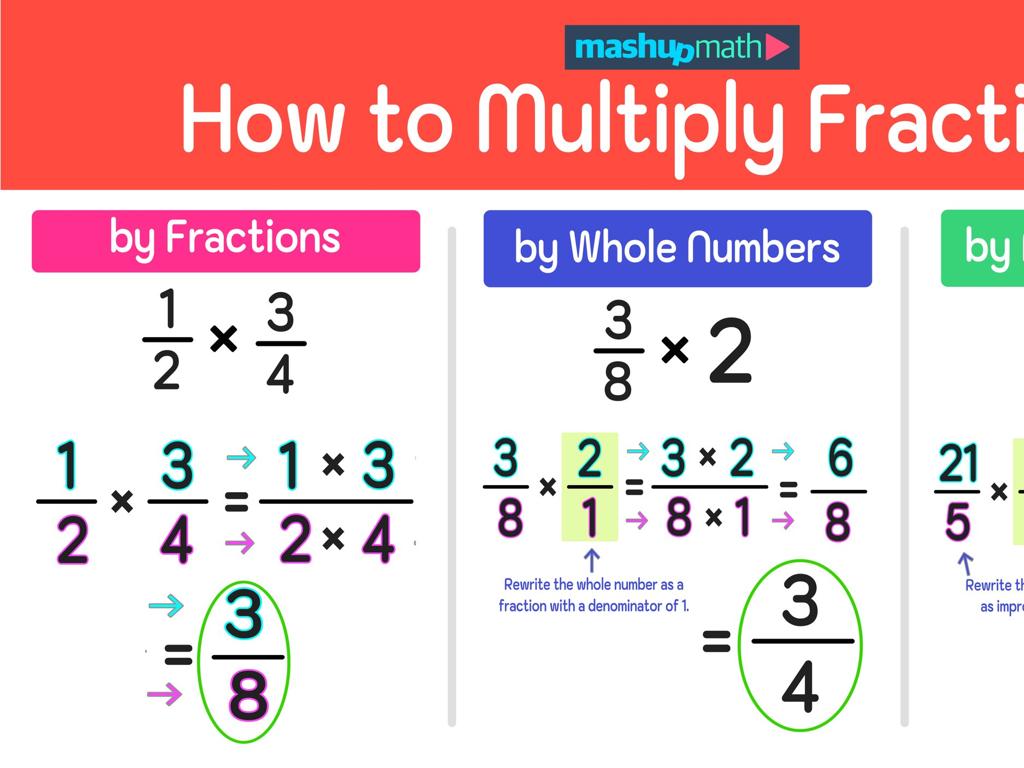Add Fractions With Unlike Denominators
Subject: Math
Grade: Fourth grade
Topic: Add And Subtract Fractions With Unlike Denominators
Please LOG IN to download the presentation. Access is available to registered users only.
View More Content
Introduction to Adding Fractions
– Recap: Fractions basics
– Fractions represent parts of a whole, like 1/2 of a pizza
– Numerators vs. Denominators
– Numerator is the top number, denominator is the bottom number
– Importance of adding fractions
– Adding fractions is used in cooking, budgeting, and more
– Preparing for advanced math
– Understanding fractions is key to algebra and geometry later on
|
Begin with a quick review of what fractions are and how they represent parts of a whole, using relatable examples like slices of pizza. Clarify the roles of numerators and denominators in fractions. Discuss real-life scenarios where adding fractions is necessary, such as combining measurements in recipes or adding different amounts of money. Emphasize that mastering fractions is crucial for students as they progress to more advanced math topics in the future. Use visual aids to help students visualize fractions and their addition. Encourage students to think of other areas where fractions are used and to share their thoughts.
Understanding Fractions: Similar vs. Unlike Denominators
– Similar denominators explained
– Fractions with the same bottom number
– Unlike denominators explained
– Fractions with different bottom numbers
– Examples: Similar denominators
– 1/4 + 2/4 = 3/4 (same denominator of 4)
– Examples: Unlike denominators
– 1/3 + 1/4 (different denominators: 3 and 4)
|
This slide introduces the concept of similar and unlike denominators as a foundation for adding fractions. Similar denominators are when fractions have the same bottom number, making them easy to add directly. Unlike denominators require a process to find a common denominator before adding. Provide clear examples for both scenarios, such as adding fractions with the same denominator directly and the need for finding equivalent fractions when denominators differ. Emphasize the importance of understanding these concepts as they are crucial for correctly adding fractions, which will be explored in subsequent lessons.
Visualizing Fractions with Different Denominators
– Use fraction circles for understanding
– Fraction circles show fractions as parts of a whole
– Compare different denominators
– See how 1/2 is different from 1/3 or 1/4
– Visualize unlike denominators
– Notice how 1/2 and 2/4 are the same size, but have different numbers
– Practice with fraction circles
|
This slide is aimed at helping students visualize fractions using fraction circles, which are a great tool for understanding how fractions represent parts of a whole. Show students how different denominators divide the circle into different numbers of equal parts. Emphasize that while the denominators may be different, the size of the parts can sometimes be the same, as in the case of equivalent fractions. Encourage students to use fraction circles to compare fractions with unlike denominators and to practice creating their own examples. This visual aid will be instrumental in their understanding of how to add fractions with unlike denominators later on.
Understanding the Least Common Denominator
– What is the LCD?
– The smallest number that all denominators can divide into.
– How to find the LCD
– List multiples of each denominator and find the smallest common one.
– Examples of LCD
– Find the LCD for 1/3 and 1/4. Multiples of 3: 3, 6, 9, 12… Multiples of 4: 4, 8, 12, 16… So, LCD is 12.
– Practice finding LCD
|
The Least Common Denominator (LCD) is crucial for adding fractions with unlike denominators. It’s the smallest number that all the denominators can divide into without leaving a remainder. To find the LCD, list the multiples of each denominator and identify the smallest number that appears in all lists. Use examples like 1/3 and 1/4 to illustrate the process of finding the LCD, which in this case is 12. Encourage students to practice with different sets of fractions, reinforcing the concept through repetition. Provide additional examples and encourage students to work in pairs or groups to find the LCD for various fractions.
Adding Fractions with Unlike Denominators
– Steps to add unlike fractions
– Find the Least Common Denominator (LCD)
– The LCD is the smallest number that both denominators can divide into.
– Add numerators over the LCD
– Keep the LCD as the new denominator, just add the top numbers.
– Simplify the fraction
– If the top number is bigger than the bottom, or if they share a common factor, simplify.
|
When adding fractions with unlike denominators, students must first find the least common denominator (LCD), which is the smallest multiple that both denominators share. Once the LCD is found, convert the fractions into equivalent fractions with the LCD as the new denominator. Then, add the numerators together while keeping the LCD as the denominator. Lastly, if the resulting fraction can be simplified or if it’s an improper fraction, teach the students how to simplify it. Use examples like 1/3 + 1/4, where the LCD is 12, resulting in 4/12 + 3/12 = 7/12. For simplification, use examples like 6/8, which simplifies to 3/4. Encourage students to practice with different sets of fractions and to check their work by simplifying their answers.
Adding Fractions with Unlike Denominators
– Example 1: Small number fractions
– Add 1/4 + 1/3. Find common denominator, then add.
– Example 2: Large number fractions
– Add 5/6 + 2/8. Larger numbers, same method.
– Step-by-step walkthrough
– Show each step: find common denominator, make equivalent fractions, then add.
– Practice problems together
|
Begin with a simple example to show the process of adding fractions with unlike denominators. Use visual aids to help students find a common denominator for 1/4 and 1/3. Move on to a more complex example with larger numbers, such as 5/6 and 2/8, to demonstrate that the process is the same regardless of the size of the numbers. Walk through each step with the class, ensuring they understand how to make each fraction equivalent before adding. Finish with practice problems, encouraging students to try on their own before reviewing as a class. This will help solidify their understanding and build confidence in adding fractions with unlike denominators.
Practice Time: Adding Fractions
– Let’s solve fraction problems
– Find a common denominator
– If we have 1/3 and 1/4, what number can both 3 and 4 go into?
– Add the numerators together
– After finding a common denominator, add the top numbers
– Simplify the fraction if needed
– If we get a fraction like 4/8, how can we make it simpler?
|
This slide is for an interactive class activity where students will practice adding fractions with unlike denominators. Start by guiding them through the steps of finding a common denominator and then adding the numerators. Use visual aids if possible to help them understand the concept of common denominators. Encourage students to participate by asking questions and solving problems as a group. Provide immediate feedback and support. For the activity, consider using fraction strips or interactive whiteboard tools to visually demonstrate the process. Have a few example problems ready, and then let students try their own, either individually or in pairs. Possible activities could include peer teaching, group problem-solving, or using manipulatives to represent the fractions physically.
Class Activity: Fraction Art
– Create fraction art individually
– Find the LCD with a classmate
– Least Common Denominator (LCD) helps combine fractions
– Combine art using LCD
– Use LCD to add different fractions in your art
– Present and explain your fractions
– Discuss the fractions in your artwork and the process
|
This activity is designed to help students understand the concept of adding fractions with unlike denominators through a creative and engaging art project. Students will first create individual pieces of art, representing various fractions with different denominators. They will then pair up with a classmate to find the Least Common Denominator (LCD) between their fractions, which is a crucial step in adding fractions with unlike denominators. After finding the LCD, students will combine their artwork by adding the fractions, resulting in a collaborative piece. Finally, each pair will present their combined art to the class, explaining the fractions they used and how they added them together. For the teacher: Prepare materials for art creation, guide students through finding the LCD, and facilitate the sharing session. Possible variations of the activity could include using different shapes to represent different fractions, or creating a fraction collage.
Wrapping Up: Adding Fractions with Unlike Denominators
– Review of fraction addition
– Practice makes perfect
– Regular practice is key to mastering new math skills
– Homework: Fractions worksheet
– Complete the provided worksheet to practice adding fractions with different denominators
– Keep practicing at home!
|
As we conclude today’s lesson on adding fractions with unlike denominators, remind students of the steps we’ve learned: finding a common denominator, converting fractions, and then adding them. Emphasize the importance of practice in mastering this skill, as it is fundamental to their success in math. Assign the worksheet as homework to provide additional practice. Encourage students to try solving the problems on their own before seeking help, as this will strengthen their understanding and confidence in working with fractions.






